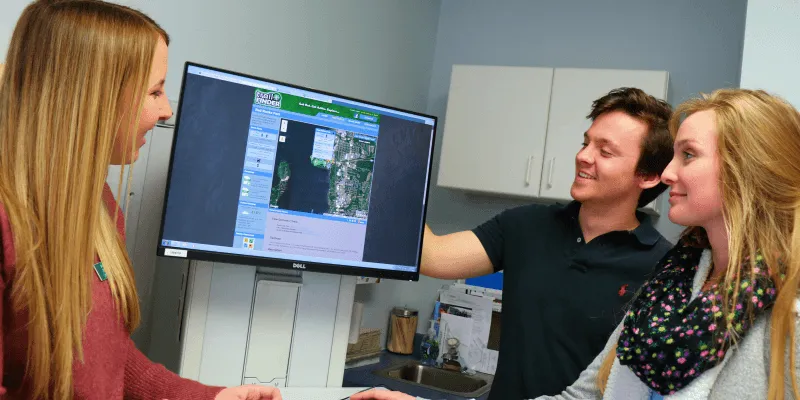Senior undergraduate nursing students in a public health nursing practicum have developed an array of resources that patients with hypertensive disease can use to personally manage their illness. These resources — instructional videos, nutrition guides, educational pamphlets -- will allow primary care providers to develop a system to support patient populations for improved community health.
The students work on their projects at Appletree Bay Primary Care, part of the College of Nursing and Health Sciences Faculty Practice in Burlington, as part of their coursework for PRNU 246 Public Health Nursing Practicum. At Appletree Bay, nurse practitioners provide primary care to patients with chronic illnesses including diabetes, asthma, hypertension, hyperlipidemia and geriatric issues. All Appletree Bay nurse practitioners teach in the UVM nursing program and mentor undergraduate and graduate students at the clinic.
Appletree Bay can offer this opportunity to students thanks to a new academic-clinical partnership between CNHS and Vermont Department of Health. Dr. Deborah Norton and Jennifer Allaire, Department of Nursing faculty members and nurse practitioners at Appletree Bay Primary Care, oversee this five-year collaboration with support from a Centers for Disease Control (CDC) grant aimed at reducing cardiovascular risk factors.
“It’s an amazing opportunity for our students,” said Allaire. “Through this grant we’re able to provide additional population health experiences, and the students are creating something useful that will have lasting impact.”
Products for Patients
Three students produced a video showing patients how to measure their blood pressure at home and keep an accurate log to share with their primary care provider.
“It’s a simple thing to do, and patients are told to do it. In the office they are shown very quickly but there’s not enough time for them to learn,” said Mary McCann, Nursing ’19. “With a video, they can watch at home and start and stop it if they need to see something again.”
Other students created a portable, printable chart that helps people make low-sodium food choices.
“Patients are told to eat healthy, but there are a lot of misunderstandings about what that means. We made a chart showing how sodium affects blood pressure and foods with different sodium levels,” said Hailee Hoffman, Nursing ’19.
“It’s a good way to have something printed and available while you are walking through the grocery store,” added Katrina Ulanov, Nursing ‘19.
Additional projects include an online, mobile device-friendly guide to local walking paths with details on accessibility to bus stops and restrooms, and a yoga-meditation video to help people reduce stress. The resources may be shared with patients by a health coach or through the Appletree Bay Facebook.
“These are real things that patients with hypertensive disease can use to manage their health when they are not in the office,” said Clinical Instructor Margaret Aitken, who teaches the course and is a nurse practitioner at Appletree Bay. “We have a much larger population of people with hypertension in our patient population than we can serve in our office, so this will have a big impact on a population level.”
Long-Term, National Impact
Erin Leighton RN, a graduate student in the Doctor of Nursing Practice program, serves as research assistant on the grant project, gathering data for the CDC to compare with other primary care practices involved in this nation-wide program. The data will help determine best practices and necessary resources for primary care facilities to manage patient populations at risk for chronic disease. Other graduate students will identify sub-populations within the larger pool of high-risk patients, such as groups of people living with food insecurity or with limited access to physical activity.
At the end of the five-year program, data may reveal similarities and differences between different types of primary care practices in managing populations of patients and suggest best strategies for reducing cardiovascular disease. The health department will share the data with the CDC.
“The information helps us make the case to policy and health system entities that this work is worthwhile to practices’ quality indicators and patient outcomes,” said Nicole Lucas, Health Systems Director for the Vermont Department of Health and faculty liaison for this grant. “We recognize that providers are busy, with multiple competing priorities and not enough time in the day. These funds allow clinic staff to participate in activities to develop systems that will lead to long-term, sustainable systems that support the entire patient population.”
For students, the academic-clinical partnership with the health department provides real-world experience as patient educators and community health providers.
“They are sifting through clinical evidence and translating the information so that patients can understand it,” Aitken said. “They are creating resources that will be used by our patients.”
